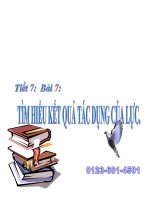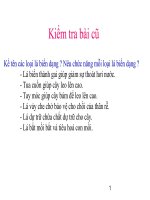BÀI GIẢNG SINH HỌC CAMPBELL pptx
Bạn đang xem bản rút gọn của tài liệu. Xem và tải ngay bản đầy đủ của tài liệu tại đây (8.43 MB, 132 trang )
Chapter
52
An Introduction to Ecology
and the Biosphere
PowerPoint® Lecture Presentations for
Biology
Eighth Edition
Neil Campbell and Jane Reece
Lectures by Chris Romero, updated by Erin Barley with contributions from Joan Sharp
Copyright © 2008 Pearson Education, Inc., publishing as Pearson Benjamin Cummings
Overview: The Scope of
Ecology
• Ecology is the scientific study of the
interactions between organisms and the
environment
• These interactions determine distribution of
organisms and their abundance
• Ecology reveals the richness of the biosphere
Copyright © 2008 Pearson Education, Inc., publishing as Pearson Benjamin Cummings
The Scope of Ecological Research
• Ecologists work at levels ranging from
individual organisms to the planet
Copyright © 2008 Pearson Education, Inc., publishing as Pearson Benjamin Cummings
• Organismal ecology studies how an
organism’s structure, physiology, and (for
animals) behavior meet environmental
challenges
Copyright © 2008 Pearson Education, Inc., publishing as Pearson Benjamin Cummings
Fig. 52-1
Fig. 52-2
Organismal
ecology
Population
ecology
Community
ecology
Ecosystem
ecology
Landscape
ecology
Global
ecology
Fig. 52-2a
• A population is a group of individuals of the
same species living in an area
• Population ecology focuses on factors
affecting how many individuals of a species live
in an area
Copyright © 2008 Pearson Education, Inc., publishing as Pearson Benjamin Cummings
Fig. 52-2b
• A community is a group of populations of
different species in an area
• Community ecology deals with the whole
array of interacting species in a community
Copyright © 2008 Pearson Education, Inc., publishing as Pearson Benjamin Cummings
Fig. 52-2c
• An ecosystem is the community of organisms
in an area and the physical factors with which
they interact
• Ecosystem ecology emphasizes energy flow
and chemical cycling among the various biotic
and abiotic components
Copyright © 2008 Pearson Education, Inc., publishing as Pearson Benjamin Cummings
Fig. 52-2d
• A landscape is a mosaic of connected
ecosystems
• Landscape ecology deals with arrays of
ecosystems and how they are arranged in a
geographic region
Copyright © 2008 Pearson Education, Inc., publishing as Pearson Benjamin Cummings
Fig. 52-2e
• The biosphere is the global ecosystem, the
sum of all the planet’s ecosystems
• Global ecology examines the influence of
energy and materials on organisms across the
biosphere
Copyright © 2008 Pearson Education, Inc., publishing as Pearson Benjamin Cummings
Fig. 52-2f
Concept 52.1: Ecology integrates all areas of
biological research and informs environmental
decision making
• Ecology has a long history as a descriptive
science
• It is also a rigorous experimental science
Copyright © 2008 Pearson Education, Inc., publishing as Pearson Benjamin Cummings
Fig. 52-3
Trough
“Dry”
Pipe
“Wet”
“Ambient”
Linking Ecology and Evolutionary
Biology
• Events that occur in ecological time affect life
on the scale of evolutionary time
Copyright © 2008 Pearson Education, Inc., publishing as Pearson Benjamin Cummings
Ecology and Environmental
Issues
• Ecology provides the scientific understanding
that underlies environmental issues
• Ecologists make a distinction between science
and advocacy
• Rachel Carson is credited with starting the
modern environmental movement with the
publication of Silent Spring in 1962
Copyright © 2008 Pearson Education, Inc., publishing as Pearson Benjamin Cummings
Fig. 52-4
Concept 52.2: Interactions between organisms and
the environment limit the distribution of species
• Ecologists have long recognized global and
regional patterns of distribution of organisms
within the biosphere
• Biogeography is a good starting point for
understanding what limits geographic
distribution of species
• Ecologists recognize two kinds of factors that
determine distribution: biotic, or living factors,
and abiotic, or nonliving factors
Copyright © 2008 Pearson Education, Inc., publishing as Pearson Benjamin Cummings
Fig. 52-5
Kangaroos/km2
0–0.1
0.1–1
1–5
5–10
10–20
> 20
Limits of
distribution
• Ecologists consider multiple factors when
attempting to explain the distribution of species
Copyright © 2008 Pearson Education, Inc., publishing as Pearson Benjamin Cummings









